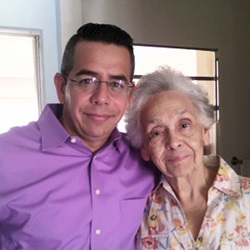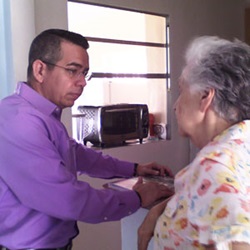A Day in the Life of a Hospice Chaplain
Robert Visits Several Patients Every Day
“The process of dying is like preparing to go on a trip,” says Robert Cemillan, VITAS chaplain. “When you are planning a trip, the preparation is what determines how the trip will be and how it will end. For this trip, you’re only allowed memories and love in your suitcase.
 Robert has been a VITAS chaplain for more than four years. He is one of hundreds of chaplains who serve on VITAS interdisciplinary hospice teams in offices across the United States. Along with a chaplain, each team consists of a physician, nurse, hospice aide, social worker, volunteer and bereavement specialist. Together, they address the physical, emotional and spiritual needs facing patients and their loved ones at the end of life.
Robert has been a VITAS chaplain for more than four years. He is one of hundreds of chaplains who serve on VITAS interdisciplinary hospice teams in offices across the United States. Along with a chaplain, each team consists of a physician, nurse, hospice aide, social worker, volunteer and bereavement specialist. Together, they address the physical, emotional and spiritual needs facing patients and their loved ones at the end of life.
A Spiritual Role That Goes Beyond Prayer
As a hospice chaplain, Robert’s duties go beyond prayer. He is the only chaplain on VITAS home care team #135 in Kendall, Florida and is responsible for the varying spiritual needs of more than 60 terminally ill patients and their families, visiting up to six patients a day. Although he covers a mostly Hispanic area, he has patients of many other religious backgrounds and cultures, including Jewish, Creole and Asian. Robert sees his role as more than religious.
“I’m more like a coach,” he says. “I help the family find their own answers and their own release from fears and worries.” On any given day, he may address the spiritual issues around Do Not Resuscitate orders, help a family make funeral arrangements, or quietly read the Bible to a patient.
Preparing for a Day of Listening
A day in the life of this hospice chaplain usually begins at 8:30 a.m., when he calls the patients he would like to visit that day. Then he reviews his notes and each patient’s routines before setting out.
“You never know what you’ll encounter when you get to a patient’s home,” he says. “Sometimes I’ll spend two hours with a family, sometimes 20 minutes, depending on what is going on.”
The most important quality a hospice chaplain can have, he says, is the ability to listen. “I often use what I call a ‘powerful question’ to encourage them to talk about their feelings. When I hear them say, ‘I’m afraid of my mother dying,’ I say, ‘I can see that; can you tell me why you are afraid?’
“I try to avoid interrupting them and let them do the talking. Then there might be some silences. When I first started as a chaplain, I found the silences hard. Now, I honor those silences, because I know that I’m not here to fix things.”
Visiting Isobel in Mourning
Today begins with a visit to Isobel, whose husband died a week ago. He was one of Robert’s first patients as a VITAS chaplain, and Robert was at his bedside when he died. Before getting out of the car, Robert slips a neatly folded handkerchief into his back pocket.
The house is quiet. Isobel’s rocking chair slowly rocks as she and Robert talk about her husband. They both glance at the empty chair beside the sofa—his chair. Robert listens as Isobel talks about her daughter, who lives three states away and wants Isobel to move in with her. Isobel says she is ready to move—there are too many memories here. She and her husband were married in 1949. But she’s not sure she wants to leave the city that has been her home for so long. Robert assures Isobel that she doesn’t have to make these decisions now. He holds her hand as they talk more about her loss; Robert hands her the handkerchief when tears appear.
Because Isobel is 83 years old, had a long and close marriage, and has no immediate family close by, her VITAS team has developed a special bereavement plan of care for her. They believe she needs extra attention throughout this mourning period, so Robert and the bereavement specialist will visit her more often than other individuals who have a stronger network of support.
The home phone rings and Robert takes this as a sign it is time to leave. He has been with Isobel for nearly an hour. “It’s important to know when to leave,” he explains later. “It’s a sign of respect to them and their time. I want to be welcome next time.” But before leaving, he encourages Isobel to call him if she needs to talk. He tells her he will be calling her and will be back to visit next week.
Fred and Elaine Face Anticipatory Grief
 There’s no need to knock at the home of Fred and Elaine* because Fred never locks the door during the day. The tall, slender 89-year-old man with a small, jaunty mustache and big smile greets Robert. His wife, Elaine, is the VITAS hospice patient. The couple has no children and no immediate family in town. After 50-plus years of marriage, Fred is struggling to accept his wife’s terminal diagnosis, while she worries about what will happen to him after she’s gone.
There’s no need to knock at the home of Fred and Elaine* because Fred never locks the door during the day. The tall, slender 89-year-old man with a small, jaunty mustache and big smile greets Robert. His wife, Elaine, is the VITAS hospice patient. The couple has no children and no immediate family in town. After 50-plus years of marriage, Fred is struggling to accept his wife’s terminal diagnosis, while she worries about what will happen to him after she’s gone.
While the hospice aide gives Elaine her bath, Robert has a chance to talk alone with Fred and find out how he is doing. Robert listens intently as Fred talks about his wife, his voice thick with emotion, a tear balanced under his eye, his fingers tapping the table. Fred is experiencing what Robert calls “anticipatory grief,” or grief that occurs before an impending death.
“When someone is dying, the family caregiver worries about the future,” Robert explains. “My role is to begin working in the present to help them try to face the future in a good way. Today, I’ll invite Fred to try just living one day at a time.”
The aide wheels Elaine into the room. She sits in her wheelchair, hair neatly combed, but tears glisten in her eyes. She is worried about Fred, a subject she and Robert have discussed at length in previous visits. Today, Robert encourages them to talk about happy memories. Fred brings out their wedding portrait and before long the couple is talking, smiling and remembering good times.
Rebecca: A New Hospice Patient
The next patient Robert visits is new with VITAS. Until yesterday, Rebecca lived in an assisted living facility. Her son, who lives out of town, wanted her to be transferred to the home of family friends and begin hospice services.
This is Robert’s first visit with Rebecca and her new caregivers. Inside the spacious home, Rebecca sleeps quietly. He takes this opportunity to introduce himself and answer any questions the caregiving couple has. He speaks to Rebecca’s son on the phone—they talk of funeral arrangements. While Robert is there, the team nurse arrives and begins her assessment of Rebecca. Soon after, the VITAS Home Medical Equipment technician delivers the hospital bed and other equipment and supplies Rebecca will need. By the time Robert leaves, the new patient and her new caregivers are in good hands.
Focusing on the Patient, Not His Personal Theology
Robert never brings his own theological beliefs or opinions into discussions. He meets patients “where they are” spiritually, as he puts it. He comes to each patient with an open mind and avoids assumptions about their religion, culture or beliefs. To those who ask, Robert will read the Bible. If he cannot read it in their language, he has an app on his phone that reads the Bible in dozens of languages. At the patient’s request, Robert can also provide the services of a priest, rabbi or other faith leader.
He says his biggest challenge is connecting with patients without letting their issues affect his personal life. His greatest pleasure is “helping provide support and hope—hope to lessen the pain, lessen the sadness and validate their suffering. To let patients and families know they are not alone.”
“My Job is a Blessing”
Robert earned a medical degree in his native Cuba, completing residencies in both family medicine and geriatrics. While working in a geriatric clinic he discovered his passion for helping the elderly. But his career took a turn when he decided to go into the ministry and began working with his local Presbyterian pastor. After earning a master’s degree in divinity from an ecumenical seminary in Cuba, he worked in his hometown of Cardenas, where he was ordained as a Presbyterian minister.
Robert immigrated to the United States in 2009 to teach at a Presbyterian school as a Bible teacher. In 2012 he completed VITAS’ two-year clinical pastoral education (CPE) program and began working as a hospice chaplain on home care team #135.
Robert sees his job as “a call from God. My job is a blessing,” he says. “I don’t feel bad about going back to work on Monday, or when my boss calls me in the middle of the night to go to a patient.” Once a month, Robert is on call, beginning at 5:00 p.m. Friday until 8:00 a.m. Saturday. Usually only called out once during that time, he says he has been called out up to four times. Most of the time these late-hour visits are to attend a death. “When this happens,” he explains, “I am responsible for recording the official time of death, calling the funeral home and supporting the family.”
“The Best Medicine is Love and Support”
At the end of the day, serving as a hospice chaplain is as simple as being present—and as complex as explaining the inexplicable.
“The best medicine for someone who is dying,” Robert says, “is to provide them with all our love and support. For caregivers, it’s listening and respecting their feelings of sadness, fear and anger.”
Each night as Robert heads home he says he reflects on his patients and on his day. “My job, my ministry, has helped me notice the value of each day. I know tomorrow is a gift so I must live an eternity in each moment.”
Are you looking for a career as a Hospice Chaplain? View our open positions today.
*Aside from Robert Cemillan and Isobel, all names in this article have been changed to protect privacy.